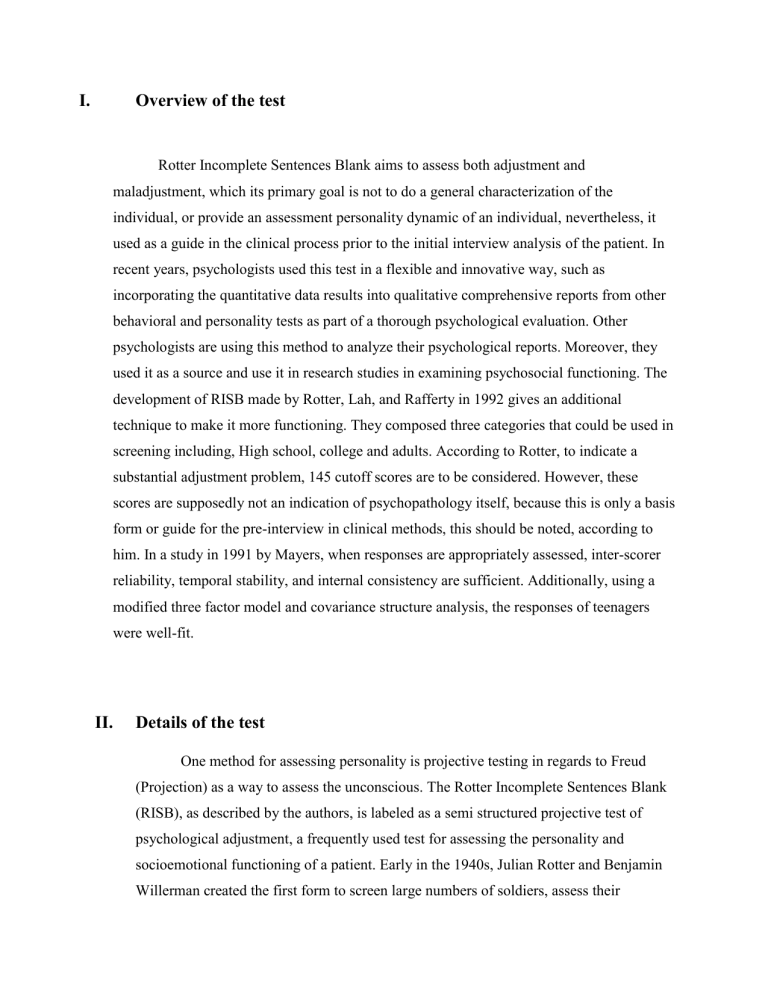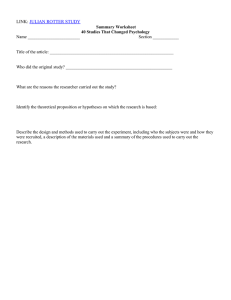Rotter Incomplete Sentences Blank - Research study
advertisement

I. Overview of the test Rotter Incomplete Sentences Blank aims to assess both adjustment and maladjustment, which its primary goal is not to do a general characterization of the individual, or provide an assessment personality dynamic of an individual, nevertheless, it used as a guide in the clinical process prior to the initial interview analysis of the patient. In recent years, psychologists used this test in a flexible and innovative way, such as incorporating the quantitative data results into qualitative comprehensive reports from other behavioral and personality tests as part of a thorough psychological evaluation. Other psychologists are using this method to analyze their psychological reports. Moreover, they used it as a source and use it in research studies in examining psychosocial functioning. The development of RISB made by Rotter, Lah, and Rafferty in 1992 gives an additional technique to make it more functioning. They composed three categories that could be used in screening including, High school, college and adults. According to Rotter, to indicate a substantial adjustment problem, 145 cutoff scores are to be considered. However, these scores are supposedly not an indication of psychopathology itself, because this is only a basis form or guide for the pre-interview in clinical methods, this should be noted, according to him. In a study in 1991 by Mayers, when responses are appropriately assessed, inter-scorer reliability, temporal stability, and internal consistency are sufficient. Additionally, using a modified three factor model and covariance structure analysis, the responses of teenagers were well-fit. II. Details of the test One method for assessing personality is projective testing in regards to Freud (Projection) as a way to assess the unconscious. The Rotter Incomplete Sentences Blank (RISB), as described by the authors, is labeled as a semi structured projective test of psychological adjustment, a frequently used test for assessing the personality and socioemotional functioning of a patient. Early in the 1940s, Julian Rotter and Benjamin Willerman created the first form to screen large numbers of soldiers, assess their compliance and fitness, providing an evaluation and treatment before returning to duty. That was the very first step that the RISB’s concept was made. However, the original and first edition of RISK was published in the year 1950 by Julian Rotter and Janet Rafferty, which has two purposes, the first one is to Measurement of adjustment and maladjustment as well as detection of psychopathology's presence or absence by serving as a guide form in clinical technique. Also, it might be used as guide diagnosis, and facilitate treatment planning. According to the test developers, Every response of the respondents, and every blank completed, stated the responses unconscious feelings and intentions. All sentence stems reveal the feelings and thoughts about themselves, their interpersonal interactions and capacity to handle psychological pressures. Psychologists in recent years, composed three categories that could be used in screening including, High school, college and adults as part of comprehensive psychological assessment. However, other psychologists use it in their psychological reports. Moreover, they used it as a source and use it in research studies in examining psychosocial functioning. Rotter Incomplete Sentences Blank, 2nd edition (RISB) In the year 1992, through Julian B. Rotter, Michael I. Lah, and Janet E. Rafferty, a recent update was published It offered a technique that could be used for screening and experimentation as well as to gather information for specific diagnostic for three different categories. There are 40 sentence stems to be answered on the RISB-2 forms, which come in three levels for high school, college, and adults. This test can be finished in 20 to 40 minutes and is administered using paper and pencil. This RISB's second edition contains: 1. Review of research that supports the clinical relevance, reliability, and validity. 2. updated normative data, scoring guidelines, and case studies are provided. 3. can be administered to a group or an individual. 4. Use in sectors such as higher education, medicine, clinical care, business, the military, teaching, and research. Format, Administration, and Scoring The revised first form employed by Rotter and Willermann in the army in 1940 served as the basis for the development of the RISB as it is constructed as a free-response adjustment measure that is simple to administer and quickly yields a score. RISB consists of 40 incomplete sentences that are usually 1-2 words long, and can be taken in paper-andpencil format. It can also be given orally without significantly influencing test results. Respondents asked to complete the sentence that usually has 20-40 minutes time, contrasting to many performance-based measures, the RISB presents stimuli example is sentence stems, that are designed to produce responses about specific psychosocial domains like friendships, romantic relationships, and work. Also, this can be administered in either individual and group settings. Responses can be scored by the semi objective scoring system in manual. Scoring criteria are provided separately for male and female college students. Conflict Responses – “C” indicating an unhealthy or maladjusted frame of mind. The intensities are categorized by: C1=4 C2=5 C3=6 Mild conflict, such as minimal worries about money, health, or friends, is indicated by responses in the C1 group. More severe signs of maladjustment fall under the C2 group, which includes issues with one's family, self-image, social isolation, and emotions of hopelessness. A severe indication of maladjustments, or C3, includes things like suicidal thoughts, sexual conflicts, serious family issues, etc. Positive Responses – indicating a healthy and hopeful frame of mind. P1=2 P2=1 P3=0 P1 responses are those that discuss having a good attitude at school, engaging in hobbies and sports, caring about other people, and expressing pleasant feelings. P2 refers to reactions that are generally positive toward other people, such as humor, social adjustment, and a stable family. Real optimism and good-natured humor are classified as C3. Answers that are neutral receive a score of 3. III. Factors being assessed The RISB analyzes psychological adjustment on an index ranging from highly adjusted to maladjusted, which is the opposite of the abilities seen in adjustment. Highly adjusted refers to a situation or test developers called adjustment (dysphoria),the ability to cope up in the situation, particularly in a difficult situation like frustration, the ability to maintain satisfying relationships and maintaining productive activity which is contrary to the maladjustments. IV. Target respondents/Qualifications of test takers In order to aid and analyze general adjustment in adolescents and adults, RISB-2 forms are offered for three levels: high school, college, and adults. As a result, the age range for qualified respondents is high school to adult age. V. Advantages/Disadvantages Advantages As the RISB is created as having the freedom of response, it is convenient for both parties. The present stimuli that are designed to produce responses about specific psychosocial domains gives an advantage to the test to be more reliable in the purpose of the test. Administration of the test is relatively efficient and opportune to the respondents, as they can adjust without any destruction to the test purpose. And lastly the method is extremely flexible, can be applied in experimental and clinical purposes. Disadvantages The scoring guidelines listed in the manual might be out of date because the test hasn't been updated since it was first published in 1950. They struggle to correspond in the scoring annual since it is out of date and has little relevance in modern society. Since the RISB did not alter the scoring criteria for high school students, it can be challenging to apply the standards for college students to adolescents. Finally, although being a regularly used test, the interpretation of the RISB based on content has no empirical backing. VI. Reliability & Validity Reliability Even though Rotter's ISB is a copyrighted test, Mayers' (1991) article includes all stems without mentioning the test's validity or dependability. Although there isn't much data to support the qualitative interpretation of the RISB, a recent study found that both adults and adolescents may use it. On the other hand, internal consistency, temporal stability, and inter-rater reliability are sufficient when responses are assessed objectively. Validity In the study that responses of adolescents from a community sample were analyzed through principal axis factoring method produces three factor structures including Clinical maladjustment, School maladjustment, and Personal Adjustment. Resulting that it showed in Covariance structure analysis that modified three factor models gave a good fit with adolescents’ responses. In addition, one study shows that Criterion-validity suggests that the RISB may be useful as a screening measure for adolescents using a 135 or 140 cut score. VII. Test developers The Rotter Incomplete Sentences Blank (RISB) Author: Julian B. Rotter & Janet E. Rafferty The Rotter Incomplete Sentences Blank (RISB 2) Author: Julian B. Rotter, Michael I. Lah, and Janet E. Rafferty ABOUT THE AUTHORS: Julian B. Rotter - He was an American psychologist who is credited with creating the social learning theory, the rotter incomplete sentence blank, and the locus of control research. Became an adviser to the United States Army WWII after earning a doctorate degree in Indiana. Became Program Director of Clinical Psychology at the University of Connecticut, and served as Chairman of the Division of Social Psychology and Personality in the American Psychological Association Janet E. Rafferty - a professional archaeologist, a co-author of Rotter Incomplete sentence blank. She graduated with both a Bachelor's and a Doctorate in Anthropology. acting assistant professor from 1974 to 1976, assistant professor from 1976 to 1977 at Southern Illinois University-Carbondale, and started her career as an assistant professor at Mississippi State University. REFERENCES: APA PsycNet. (n.d.). Basmayor, A. (n.d.). Rotter Incomplete Sentence Blank. prezi.com Construct Validity of the Rotter Incomplete Sentences Blank with Clinic-Referred and Nonreferred Adolescents. Journal of Personality Assessment Rotter Incomplete Sentences Blank | Second Edition. (n.d.). Sentence Completion Tests: A Review of the Literature and Results Weis, R., Toolis, E. E., & Cerankosky, B. C. (2008). Construct Validity of the Rotter Incomplete Sentences Blank with Clinic-Referred and Nonreferred Adolescents. Journal of Personality Assessment
